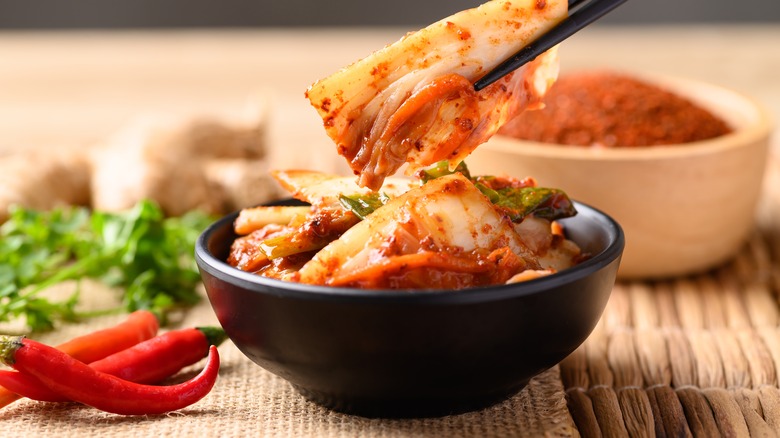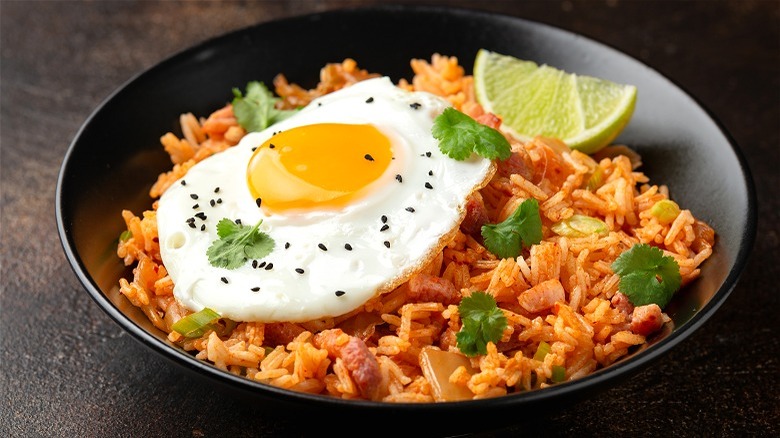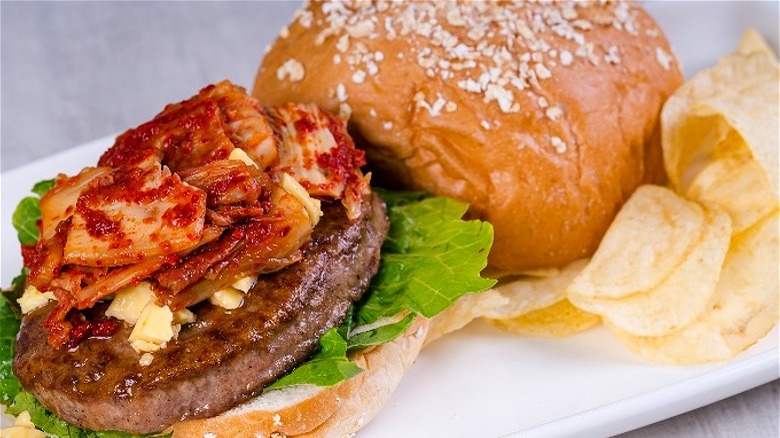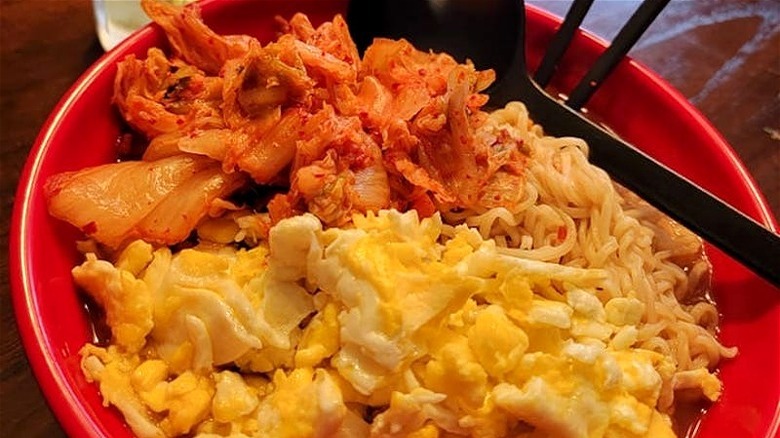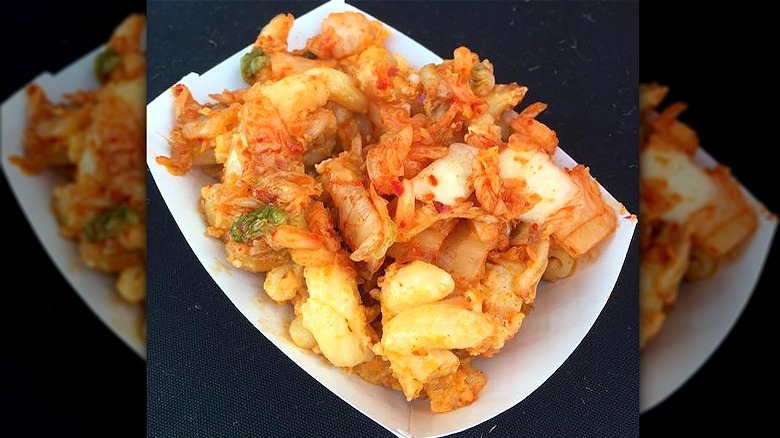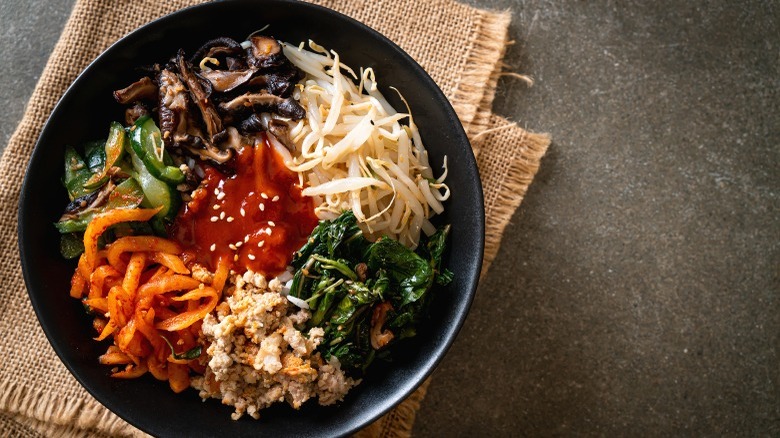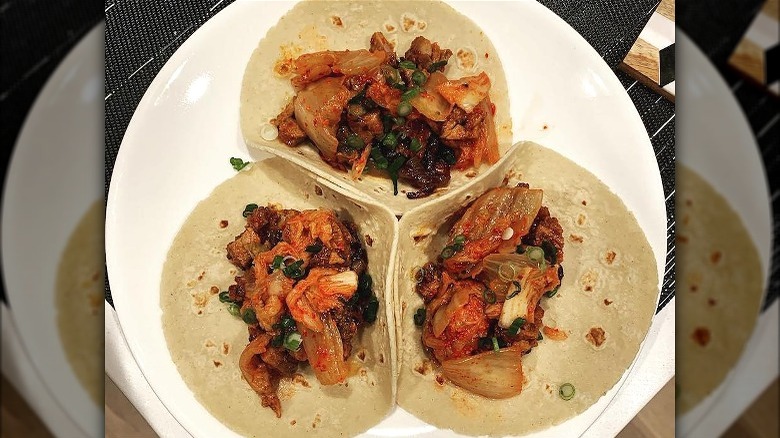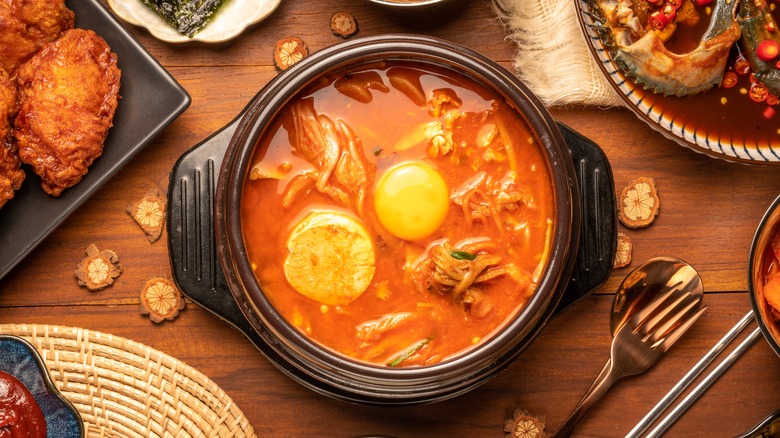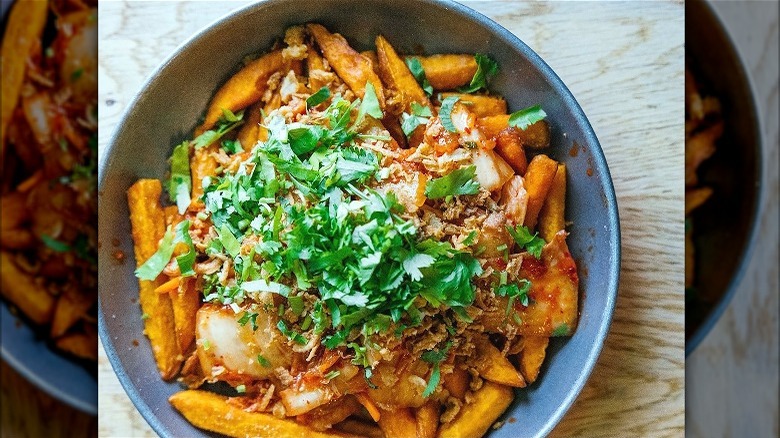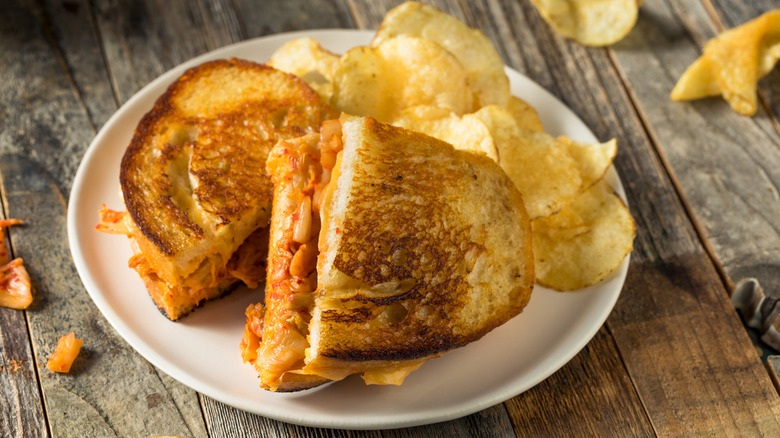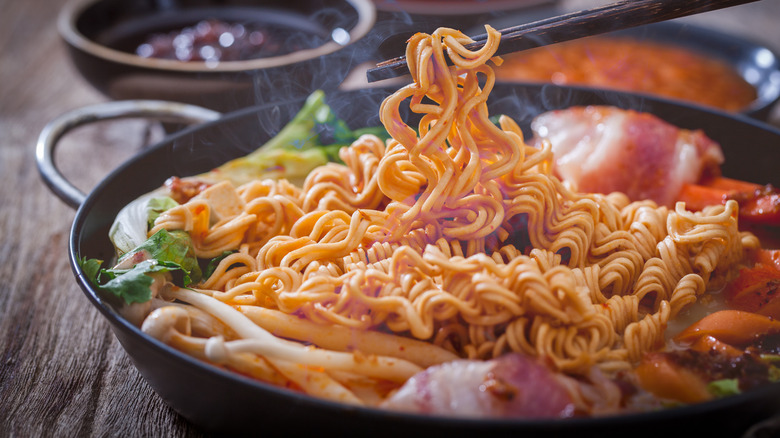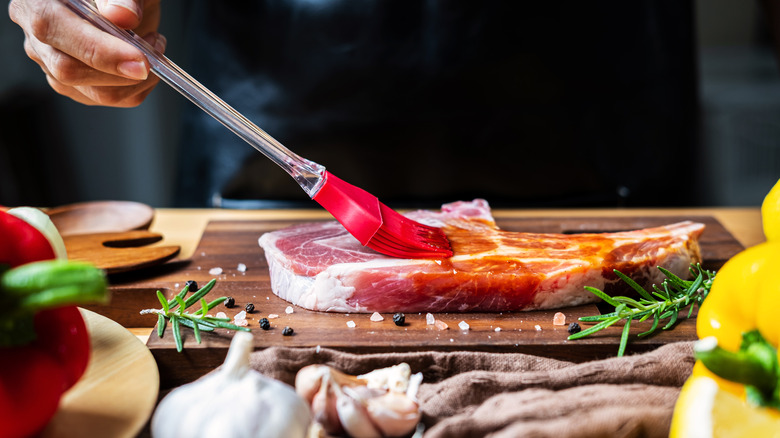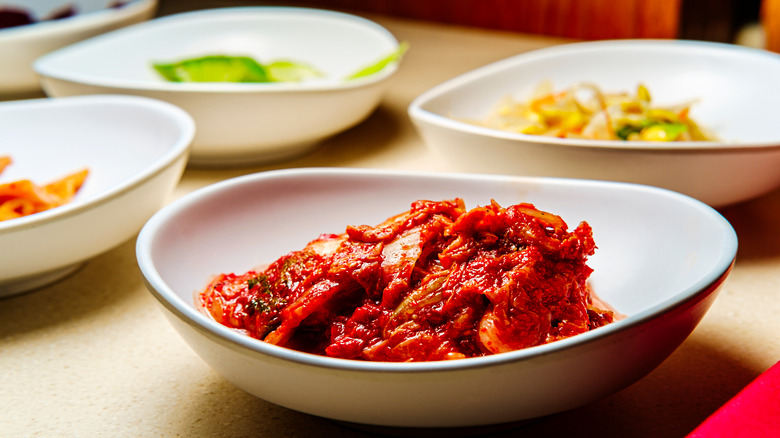14 Of The Best Ways To Use Kimchi
People are getting more familiar — and more creative — with the Korean staple of kimchi. This spiced, fermented vegetable dish is a powerhouse of flavor and probiotics. It is typically made from a combination of cabbage, chili, salt, fish sauce, ginger, and garlic.
Ashley Park, operations manager for Gangnam Kimchi, described some of the ways that kimchi can be used creatively: "Growing up in a Korean-American household, a lot of Korean foods would find their way into non-Korean meals. My experience with food made me realize that heritage doesn't have to be purely traditional to be authentic — it can be honored by delicious flavors to remind us that there are no lines, no rules in food or culture. If you think about it that way, the creativity and opportunities are endless" (via Deli Market News).
The excitement surrounding kimchi is contagious. As this food becomes more mainstream, people are becoming more curious about it. If you've jumped on the bandwagon and bought a few jars of it, you might be wondering what to do with it. You've come to the right place. From American comfort foods to Asian staples, here are 14 of the best ways to use kimchi.
1. Enhance fried rice
Fried rice is a great way to use up leftovers. After a day or two in the fridge, leftover rice becomes stiff and dry. The best way to salvage it is to fry it. Since kimchi also generally gets better with age, you can use it to turn up the heat of your fried rice.
To make kimchi fried rice, start by chopping it into bite-sized pieces. Then, fry these pieces. Before you add in the rice, look through your fridge. Adding leftover meat or veggies can help you make the dish more substantial, making something from nothing. However, kimchi fried rice is far from a throwaway meal. In Korea, this dish is actually a staple called bokkeumbap. This dish is so popular that some people will prepare rice with the sole purpose of using it to make bokkeumbap.
Raw kimchi and rice alone are delicious. But when you add heat and slightly brown the rice, it triggers that Maillard reaction that makes our mouths water. The key is getting the rice crispy enough that you have to scrape it from the bottom of the pan. If that sounds tasty, try turning yesterday's leftovers into today's dream by making kimchi fried rice.
2. Put it on a burger
Saying Americans love burgers is an understatement. According to a 2022 survey published by Statista, burgers are one of the most popular dishes in the country. U.S. citizens can't get enough of those juicy grilled patties. Perhaps it's also because burgers are simple and unpretentious. Another thing to love about burgers is that they're shockingly versatile. All of the burger fusions out there are proof of this fact. Everyone's heard of bacon burgers or jalapeño burgers, but kimchi burgers also deserve a spotlight.
The kimchi burger is an inspired creation popping up at more and more restaurants. Even some McDonald's locations in Asia have added a Korean burger to their menus. But there's also a famous kimchi burger offered in America. At BiergartenLA, you can try a Chosun Burger. This menu item consists of an Angus chuck patty, melted cheese, Spam, kimchi, and pickled daikon. Just when you thought it couldn't get better, it's drizzled with gochujang aioli and spicy mustard. That's a lot of flavorful, Korean-inspired toppings.
You don't even need to go to Los Angeles' Koreatown to make a satisfying kimchi burger. It's easy enough to make one at home using a few simple ingredients. Add grilled kimchi — or raw, for real kimchi lovers — on a cheeseburger. We recommend adding some sauces, like gochujang and mayonnaise, as well.
3. Spice up scrambled eggs
It doesn't take a master chef to make scrumptious scrambled eggs. Even your standard scramble, made with just a little salt and pepper, is a crowd-pleaser. In fact, in a YouGov survey on breakfast preferences, scrambled was the most preferred way to consume eggs.
But the next time you make scrambled eggs, we recommend spicing things up. Kimchi, eggs, and bacon — or even Spam, which is popular in Korean cuisine — can be used to elevate this morning meal. Start by caramelizing the kimchi and bacon bits, then mix in the eggs. These additional ingredients add only three to five minutes to your cooking time, but they contribute oodles of umami flavor. If you need to eat on the run, wrap this scramble into a breakfast burrito, or make a kimchi breakfast sandwich.
Making kimchi scrambled eggs is an easy upgrade. It also can go a long way for gut health, since eating fermented vegetables can contribute to a balanced microbiome (via Harvard Medical School). If you want to set your digestive system up for success, then start your day with a kimchi scramble.
4. Intensify mac and cheese
Kimchi macaroni and cheese is now a popular comfort food dish. It's cheesy, spicy, and starchy — all in one delectable meal. Also, the cheese tames kimchi's intensity, making it a more approachable and harmonious dish. However, that dash of Korean flair contributed by kimchi doesn't go unnoticed. You'll still pick up on a spicy tang.
If you're new to the kimchi world but love macaroni and cheese, start here. No need to get all fancy with it — just mix kimchi with a simple boxed macaroni and cheese, such as Kraft. To make it even better, kids love macaroni and cheese. If you're trying to introduce them to fermented foods, this is a good dish to start them with. If you're a fully-fledged adult, you can also enjoy this dish. Kimchi ups the health factor and makes it feel slightly more refined. That's what we call adulting.
5. Add it to a bowl
There's something oddly comforting about eating out of bowls. You can hold your meal in your hand, while allowing all of the ingredients to run into one another. With rice bowls, we wouldn't want it any other way.
You can use rice as a base and allow additional goodies to liven things up. A standard rice bowl is topped with protein, vegetables, and sauce. It's one of those dishes you can whip up with whatever's lying around. If you have leftover kimchi, it can function as both a vegetable and a sauce. This spicy and tangy ingredient also adds a welcome zing.
Additionally, kimchi is far more versatile than we credit it for. Fermented veggies, like the ones commonly used for kimchi, pair well with many flavors. Whether you're going for a salmon poke, a burrito bowl, or classic Korean bibimbap, kimchi delivers something special to your rice bowl.
6. Try it on a taco
In Korea, meat, sauces, and kimchi are often combined in lettuce leaves and eaten like a taco. So when the concept of Korean fusion tacos was introduced to the U.S., it didn't seem like much of a stretch. Chef Roy Choi was one of the first to popularize this recipe. Starting with a single food truck in 2008, Kogi has since expanded, developing a strong cult following.
But there's no need to track down food trucks to enjoy the fabulousness of this Korean-Mexican mashup. You can purchase some takeout, or create your own taco bar at home, adding kimchi to each.
Fresh kimchi goes a long way in this meal. It's especially excellent when used in shredded chicken and avocado tacos. If raw kimchi is too tangy for your liking, grill it first. Why stop at tacos? You could even add kimchi to quesadillas, nachos, or chilaquiles.
7. Enhance a stew
Acidic foods are flavor enhancers for many dishes. Foods like lemon, limes, and vinegar help balance other flavors while brightening up bland-yet-healthy meals. Fermented foods like pickles can also add acid to a meal. As an acidic and fermented food, kimchi works the same way.
Kimchi can be added to almost any soup or stew. Its savory flavors bring that umami quality that vegetable soups often lack. While eating heavy meat or bean soups, you can also use kimchi to freshen and lighten things up.
If you're looking for inspiration, check out some traditional Korean recipes. There are tons of Korean soups and stews made with kimchi. Budae jjigae — also known as army stew — was created shortly after the Korean War, when food was scarce. As such, people combined easy-to-find ingredients like processed meats, vegetables, kimchi, and seasonings. Many similar ingredients may already be in your pantry.
8. Load up fries
There are no limits to how you load up your fries. Think kimchi, cheese, scallions, and avocado. For those meat lovers out there, try bacon or bulgogi. These base ingredients will make your dish more substantial and flavorful.
With loaded fries, you also can't skimp on the sauce. Kimchi fries go especially well with condiments such as sriracha, gochujang, or mayonnaise. Although regular potatoes never get old, sweet potato fries pair exceptionally well with kimchi.
You really can't go wrong with kimchi fries. Just make sure to caramelize the kimchi and serve everything piping hot. These fries are sure to impress all sorts of guests — especially fast food lovers and fans of spicy food. They're also the perfect happy-hour snack, weekend indulgence, or lunchtime meal. Although traditionally served as a side, kimchi fries are substantial enough to stand alone. Don't hesitate to try making this dish at home.
9. Put it on a grilled cheese
A kimchi grilled cheese has all the foundational elements of a delicious, satisfying dish. It's salty, cheesy, and salty. It's no wonder that this type of sandwich went viral on TikTok in 2023. In one popular video, Korean food celebrity Maangchi makes grilled cheese with four simple ingredients: bread, butter, mozzarella, and kimchi.
It's the details that take this recipe to the next level. First, grill your kimchi and bread with butter in the same pan. Next, flip the bread slices and add cheese. Then add the hot kimchi. Finally, stack your bread slices on top of one another. Sandwiched between heat, the cheese will melt at just the right speed. This part is crucial to creating a perfectly crispy grilled cheese. One might even call it a "kimcheese." If you really want to go all out, add some crunchy bacon strips before sealing the sandwich.
10. Stir it into ramen
For a cheap and cheerful dish, stir kimchi into your favorite ramen. At its core, ramen is simply noodles and broth. Adding kimchi can take this meal from simple to sensational.
When making ramen at home, it's a choose-your-own-adventure style of cooking. The easiest route is to add store-bought kimchi to instant ramen. This combination is salty, but we're not complaining. Alternatively, you can make your own ramen from scratch. Follow any basic kimchi ramen recipe, but take liberties as you see fit. To kick up the flavor up a notch, add broth and gochujang paste, then top it with some dried seaweed flakes.
You can even buy kimchi-flavored instant ramen. On one Reddit thread, ramen fans explore the wide world of prepackaged kimchi ramen. According to this community, ramen from the brand Mike's Mighty Good doesn't appear to taste much like kimchi. However, the brand Jongga Real's ramen does. But if you're after heat, we recommend purchasing ramen from the brand Samyang.
11. Toss it into a salad
Some ways to use kimchi degrade its overall health benefits. Heating fermented products can destroy some of their probiotics, according to Verywell Health. If it's purely kimchi's health benefits you're after, we recommend eating it raw. You can do this by tossing it into a salad. We recommend chopping the kimchi into small pieces, then mixing the salad thoroughly to distribute the flavor.
Kimchi goes best with savory salads, pairing especially well with avocado. But don't neglect bean salads either — kimchi enhances a three-bean or lentil medley. This fermented food goes well with these ingredients because they all balance kimchi's spice. If you have trouble tolerating the flavor of raw kimchi, try a salad. Just remember that a little bit goes a long way.
If you're interested, you should try geotjeori. This is a Korean salad consisting of bok choy and unfermented kimchi. It's generally made at home, with fresh Napa cabbage. While it won't have the health benefits of fermentation, geotjeori is a crispier kimchi that contains less sourness.
12. Sprinkle it on pizza
It's time to step up your pizza toppings with kimchi. With its large Korean-American population, it's no wonder that Los Angeles is responsible for creating so many innovative kimchi recipes. It's in this neighborhood that you'll find Olivia Restaurant, which serves its own version of kimchi pizza. Theirs is a spinach pizza, made with jammy kimchi. At the end of the day, Olivia's kimchi pizzas are fire, in every sense of the word.
If you're practicing your chef skills, there are a few ways to incorporate kimchi into your homemade pizzas. Baking it right into the sauce may be the best option, especially if you incorporate a Korean paste such as gochujang. Alternatively, you can sprinkle the kimchi right on top. It goes well with spinach, soppressata, jalapeños, and more. Overall, the kimchi and cheese combo never gets old. If kimchi grilled cheese tickles your taste buds, sprinkle some kimchi on your pizza, as well.
13. Marinade meats in it
Marinades are used to impart flavor and tenderize meat. Kimchi does both swimmingly. It is a natural tenderizer.
Making kimchi into a marinade is easy. Whether homemade or store-bought, kimchi comes in its own juices. You can feel free to use as much juice as needed from the jar. You can also use some of the fermented veggies. If you need more liquid, we recommend adding some soy sauce. If you're gluten-free, you can use coconut aminos as a substitute for this element. Drizzle the marinade on top, then refrigerate it for a few hours. For additional meat tenderization, you can use a mallet.
The kimchi-marinated steak will satisfy your umami dreams. It is extremely savory and flavorful. The tangy, garlicky flavor is enough to carry this dish. But if you want to eat even more kimchi, slice the steak and add it to a kimchi rice bowl.
14. Serve it as a side
While you can get super creative with this fermented food, you don't have to. Nearly every Korean meal is eaten with kimchi, so why not serve it as such? However, this dish needs to come with something. Since kimchi is so salty and pungent alone, it works best as an accouterment.
For this very reason, Korean side dishes called banchan are a whole category of the country's cuisine. At a typical Korean meal, a multitude of these little plates fills the table. They have a set place alongside staples like rice and meat. Although there's a variety of banchan, kimchi always makes the cut.
This is probably because kimchi is far more versatile than it first meets the eye. Whether you're serving potatoes, grains, or even a charcuterie tray, kimchi can accompany your meal. It's sure to crank up the heat with that flavor we love.
